

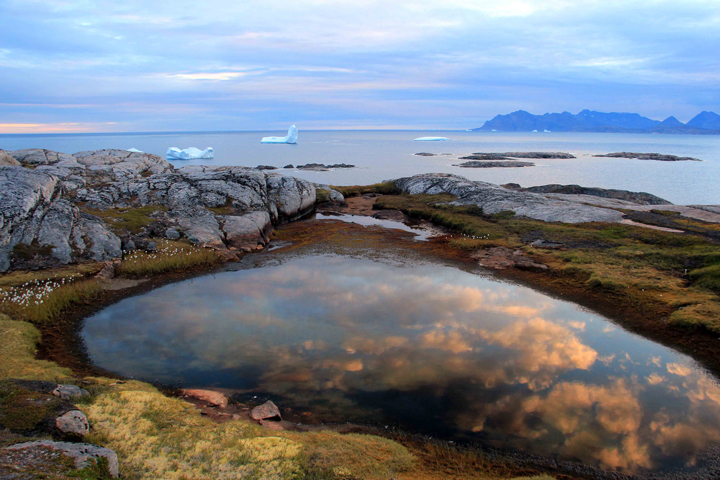
Nice cloud reflection on my last evening hike near the old harbor of Kulusuk.
Hi there,
Last blog post of for this field season, as Olivia mentioned in her science post, we were able to collect an important amount of high-quality data to further our knowledge of firn aquifers and try to answer the following research questions:
To learn more on how we try to answer these questions, I invite you to read Olivia’s post where each method is described in more details.
To wrap up, I am using bullet points and I am dividing them into themes: weather, camping, and science.
Weather:
Camping:
Science:
That is about it for our fieldwork summary, below, I have tried to summarize our work with photos in a chronological order. I hope you enjoyed reading the different blog posts and on the behalf of our team, I would like to thank you very much for following our journey in Southeast Greenland.
All the best and see you next time,
Clém

Preparing our first sling load at the airport (left), ready to be picked up by the helicopter a few minutes later (right)

Setup of our bear-proof camp. First, a trip wire which if tripped, triggers a loud alarm (sounds like a car alarm) and warn us about a possible encounter. The second layer of protection is a fence to shock the bear, and everyone had bear horns and bear spray. But we also carried a rifle in case the previous methods failed to scare the bear away.

Downloading data from both the Utrecht weather station (left) and our other station logging 50 temperatures in the firn and water-table level changes (right).
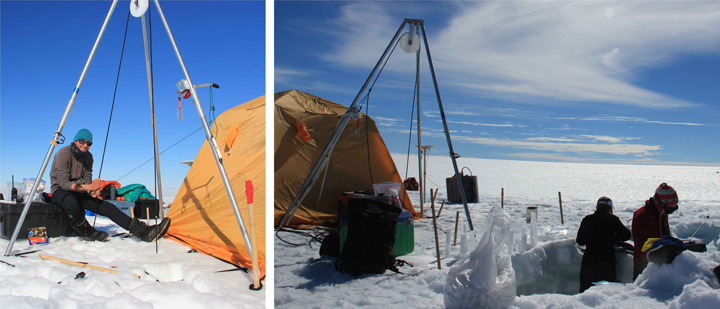
Drilling (left) and processing the firn and ice cores (right).
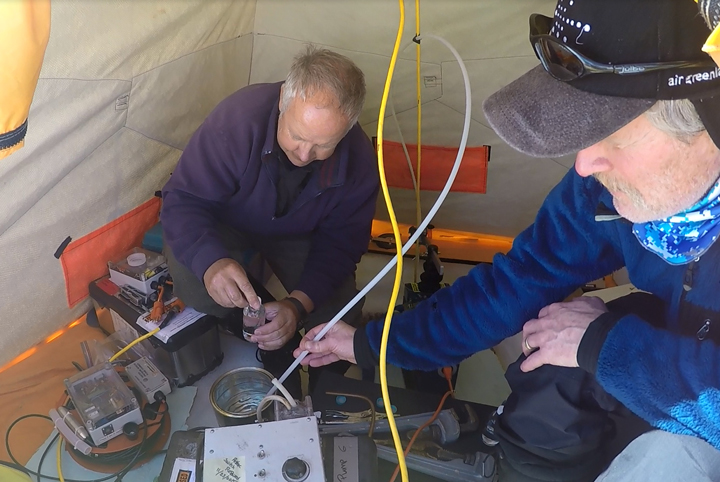
Kip and Rick sampling water from the firn aquifer.
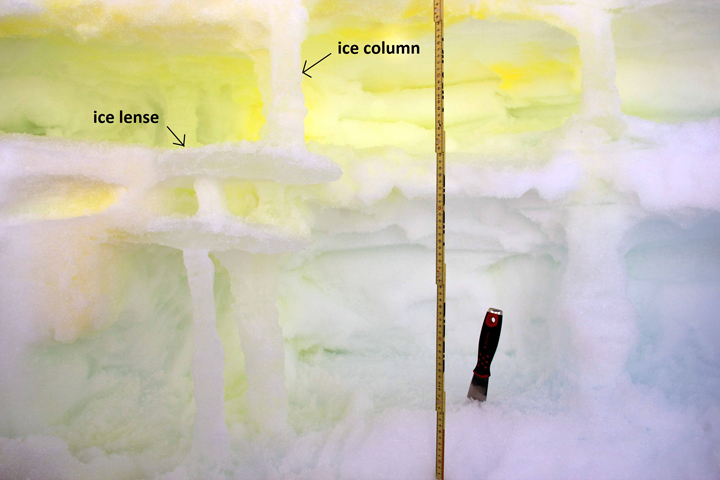
Excavating ice columns and ice lenses after spraying neon-green dye at the surface to look at water infiltration processes.
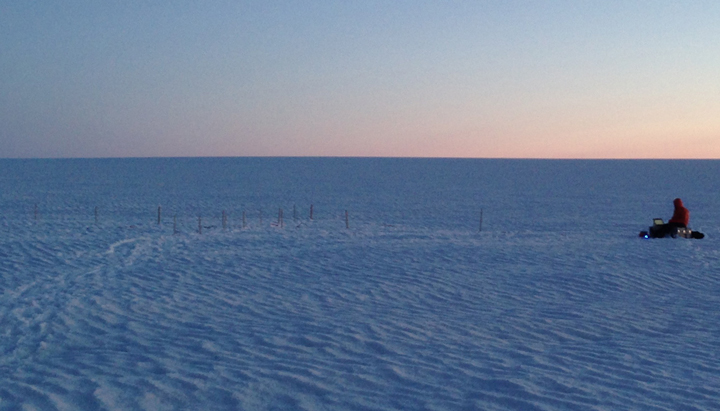
Working after dinner on a small-scale seismic survey in nice the evening light.
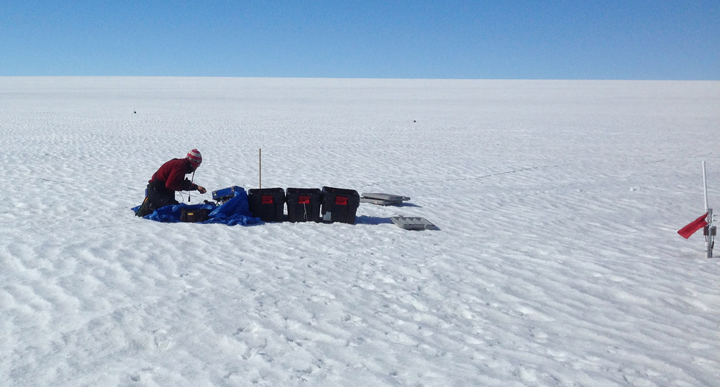
Getting the MRS measurement started after setting up the 80 by 80 m loop. On the right, one of our logging station after one year of data collection, only the top of the mast (ARGOS antenna) is above the snow surface.

Team photo on our last day with team members being hot in their ECW (extreme cold weather) gear! Actually, the tropical weather out there motivated us to pull out our leis too 😉
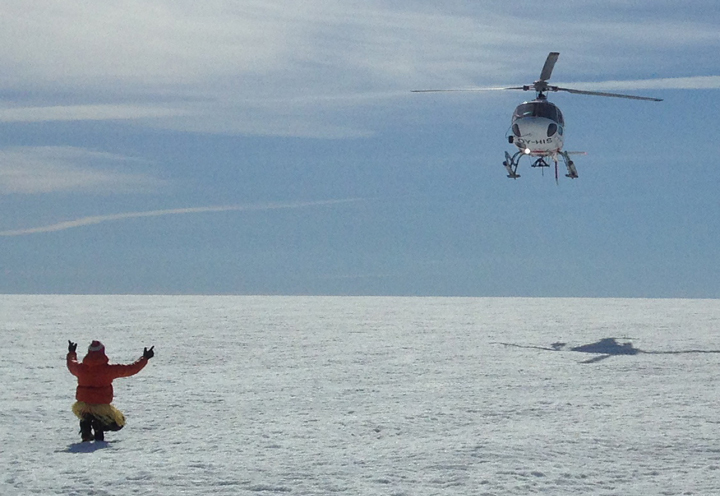
Aloha! After 20 days of work, the helicopter is coming back to get us, we greet with Hawaiian style!

Olivia hands our precious water samples to Johannes for loading them in the helicopter as our first priority.
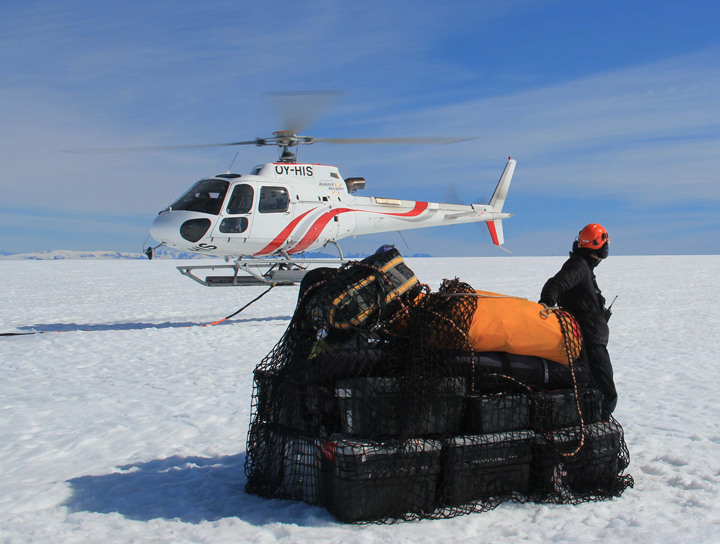
Nick (orange helmet) has the last sling load ready to go and is getting prepared to hook it on to the cable attached to the helicopter.
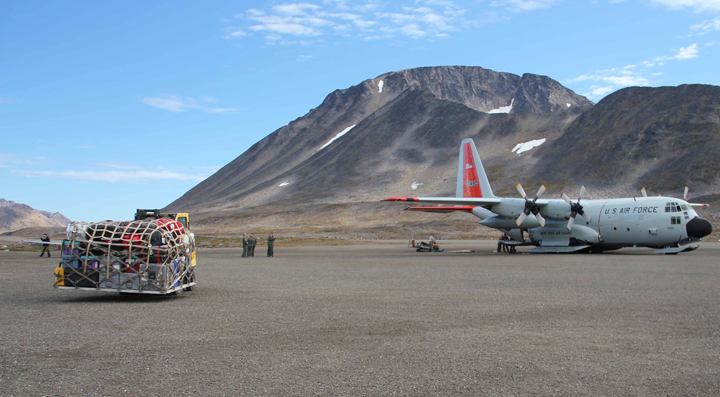
Back in Kulusuk, we spent a few days packing up the equipment. On the last day a LC-130 came from Kangerlussuaq to pick up a few thousand pounds of equipment. You can barely see the small forklift from the airport moving the Air-Force pallet at the back of the plane.
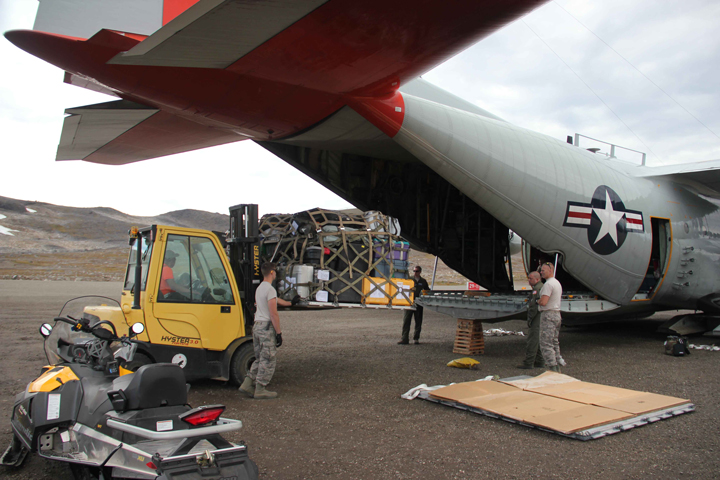
Loading up the science equipment into the plane.
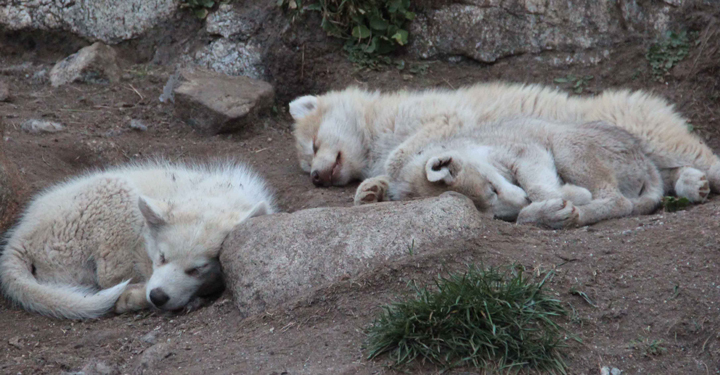
Peaceful and sleepy husky puppies in the evening.
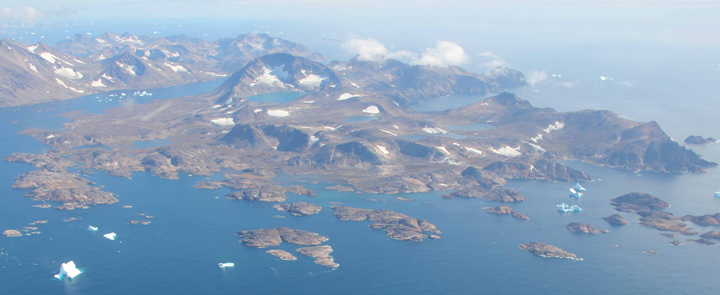
View of the Kulusuk Island from the air. At the left you can see the airport runway and on the right, you might be able to spot the DYE-4 station.
Hi there,
After a science-packed 3 weeks on the ice sheet, the team has returned to Kulusuk, more successful than we ever expected. We accomplished the following:
First, I’ll describe a little bit about life on the ice sheet, followed by a description of the science work we did.
On a typical day, we get up around 7 and begin melting ice to make water so we can make breakfast. We generally eat instant oatmeal or, on special days, pancakes. We discuss our plans for the day and make a daily check in call to get weather updates and logistics support. This year, with 6 people in the field, we were able to divide into groups of 2 or 3. Generally, we had an ice core and hydrology team and a geophysics team. The ice core drilling and hydrology team would drill ice cores and install wells. The geophysics team did the seismic, magnetic resonance, and GPR work. Some days our work sites were in camp and we could eat a hot lunch, and other days we commuted to remote sites and packed a lunch. We had daylight until close to midnight so we often worked until 7 or 8 at night, before heading back to the cook tent to melt snow for dinner. For dinner, we eat things like pasta, couscous, or indian food that you boil in a bag. The weather was fantastic for our field work. The highs were around 5C and the lows and night were around -5C. We only had two cloudy days, which were actually a nice break from the intense sunlight we experienced the rest of the time.
Right before we went out to the ice sheet, we heard news about a polar bear entering a science camp much farther north. In response to this scary news, we beefed up our bear protection. We placed our 4 sleep tents close together, surrounded first by an electric fence and then by a trip wire that sets off a loud alarm when it is broken (I know it is loud because we had a few false alarms in the middle of the night! I have never jumped out of my 2 sleeping bags and tent so fast!) We also carried a rifle, bear spray, and noisemakers. Luckily, the only wildlife we saw was a bird on our last day on the ice.
Now for the science!This field season we had a very ambitious plan for the seismic imaging of the base of the aquifer. Based upon what we learned in last year’s field season, we wanted to investigate more of the ice lying beneath the aquifer. To do this with our seismic refraction lines, we needed to have a much longer line (540 meters vs. last year’s 275 meters). This required flipping the line of geophones after shooting the first one, and then reshooting the reversed line. Each line took 340 hammer swings to complete, with an invigorating 30 shot stack at either end being the big challenge for the hammer swingers. We also wanted a regular spacing of the seismic lines this field season; this required a bit more travel than last year on the snowmobile, with a total of 12 seismic lines spaced nearly every 2 kilometers. Some really interesting structure emerged from all this work, with in-field analysis allowing us to find the base of the water-ice transition and even see the ice-rock interface at the bed! Everyone lent an arm to the seismic work, for a total of 4120 recorded hammer swings (and a pretty dented metal plate)!
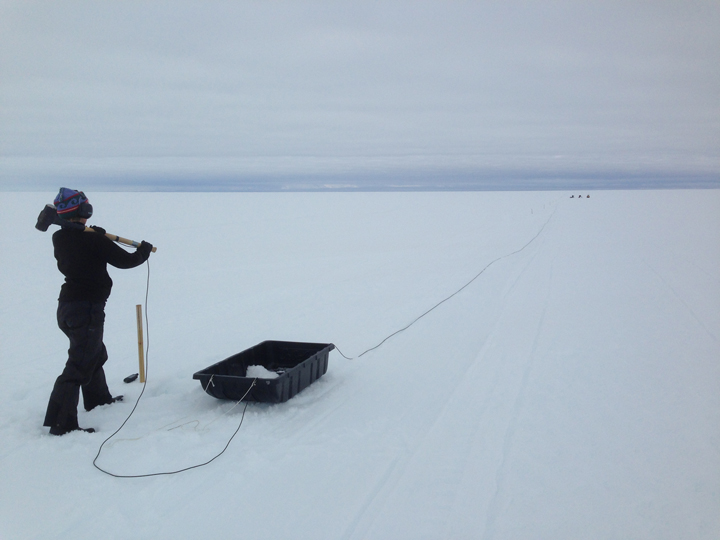
Olivia waiting for the okay to swing the hammer one more time.
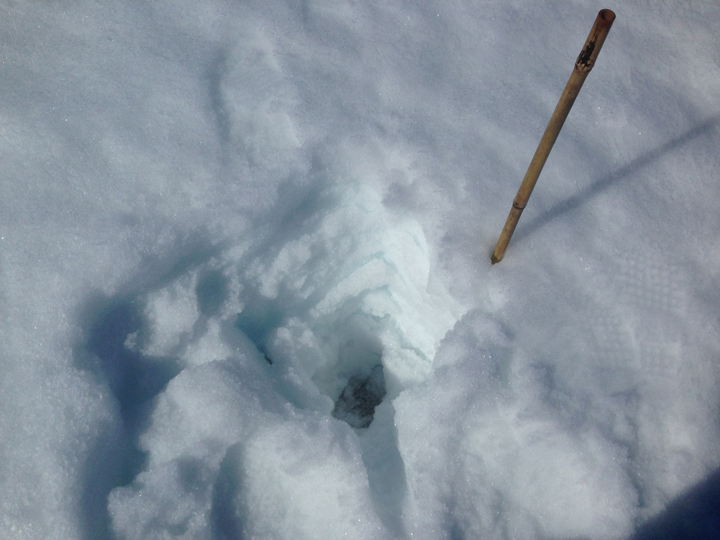
A buried plate after 30 hammer swings.
In addition to the seismic experiments, our team performed some magnetic resonance soundings and ground-penetrating radar (GPR) surveys. These two measurements combined with the seismic data help us to understand the firn aquifer structure as a whole. While the seismic measurements give us a good idea of the transition of the firn aquifer to the ice, the ice-penetrating radar was able to precisely (30 cm resolution) image the water table by sending electromagnetic waves from the surface and recording the time it takes to get them back (like a sonar on a boat). Combining seismic and radar data allowed us to get both top and bottom of the firn aquifer, therefore its thickness and its variations in space and time.
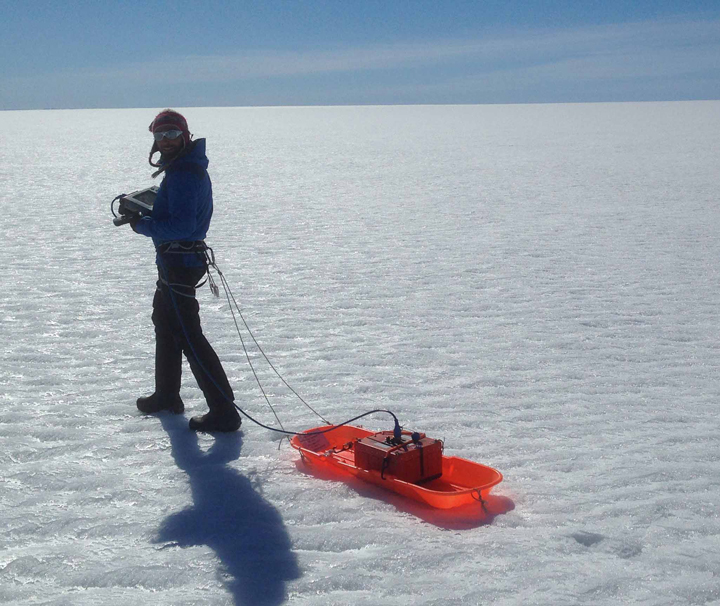
Initial GPR measurements by foot to check the presence of water and its depth. Later on we used a snowmobile to tow the radar.
The magnetic-resonance soundings (MRSs) complement the two previously described techniques by giving the total volume of free water (liquid) at each location. To measure the liquid water volume, we laid a loop of wire in a square shape, 80 x 80 m. This wire loop acts as both a transmitting and receiving antenna. For a short time, we transmit a current pulse at a known frequency through the firn and then allow the same antenna to receive the magnetic resonance response. Since only the proton in the water can generate a magnetic resonance signal at a precise frequency, we can estimate the water amount present within the wire loop.

RS equipment ready for a sounding. Usually a sounding lasts between 3 and 5 hours based on how noisy the signal gets (the noisier it is, the longer the sounding takes).
Those three techniques (seismic, GPR, and MRS) complement each other nicely giving us crucial parameters to study the water present in the firn aquifer over our fieldwork location. During the 20 days in the field we were able to make 10 magnetic-resonance soundings and collect up to 100 km of GPR data, which will gives us very good spatial resolution while understanding the spread of this firn aquifer.
On the hydrology side, we installed wells and took water samples, measured permeability, and the water level like we did last year in 3 new locations. We also added a few new experiments. We did one experiments called a point dilution test where we injected salt water into the aquifer and measured how the fresh water flowing through the aquifer diluted the salt water. We can use these measurements to estimate how fast the water is flowing through the aquifer. This was really fun because we could see very quickly that the salt diluted more quickly in some parts of the aquifer than others, which tells us that the water flows at different rates in different zones.
Last summer we tried a test to measure how permeable the aquifer is called a pumping test. During a pumping test, you pump water out of the aquifer and measure how much you can lower the water table. If the water table doesn’t go down very much, it means that the water nearby can flow to the pump fairly easily. If the water table goes down a lot, it means that the water in the surrounding firn cannot flow easily enough to keep up with all the water you pump out. This summer we improved this test and were able to pump 1 liter of water per second out of the ice sheet for 5 hours! And even with all that pumping, we barely lowered the water table. This tells us that the firn is very permeable. Watch the video below to see the pumping test in in action.
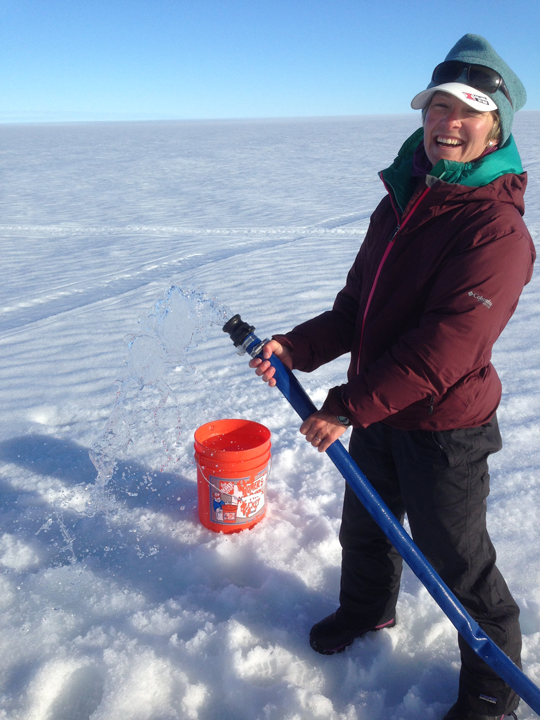
Pumping lots of water out of the ice sheet!
We also drilled ice cores at the same three sites. We measure the size and mass of each core, to determine the density of the firn and how it changes with depth. We also did a new test this year to measure the water content of the cores, and collected firn samples for chemical analysis.
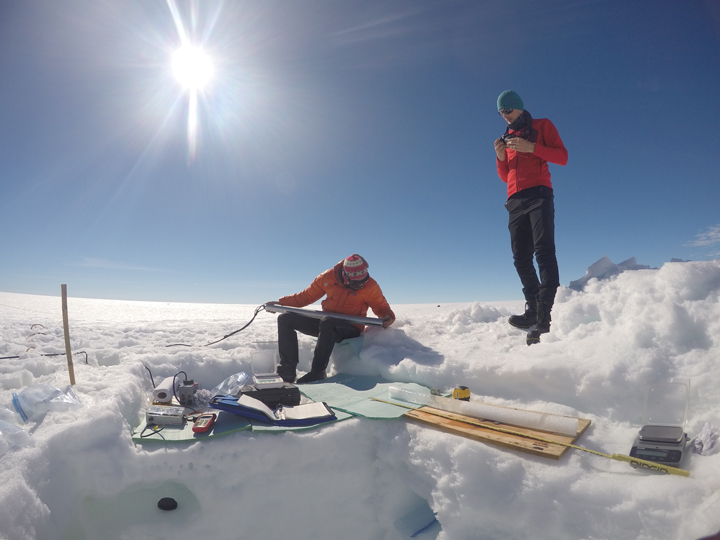
Clem and Stefan studying an ice core.
All in all, we got tons of data that tells us about the aquifer structure, where the water comes from, how fast it flows, how much liquid water is stored within the ice sheet, and what impact it has on melting of the ice sheet and sea level rise.
This was a fantastic team to spend 3 weeks in isolation on the ice with! Everyone worked hard and pitched in to help each other out. We all got a chance to try doing field work for all the different kinds of science going on too. This was a really fun way to learn about other people’s work.
Now that we are back in Kulusuk, we have some work to do drying our equipment out and pacing everything up in preparation to ship it home. Time flies in the Arctic. The sun is setting much earlier, and there is a little hint of fall in the air.
Last Saturday, part of the team arrived safely in Kulusuk! Olivia, Clem and Stefan flew in two hours with Air Iceland from Reykjavik (Iceland) to Kulusuk (East Greenland). This is one of a few international airports on the east side of Greenland and also the home of our container full of camping and science equipment. For me, this is my first time in Greenland and I am glad I can share these first impressions with you.
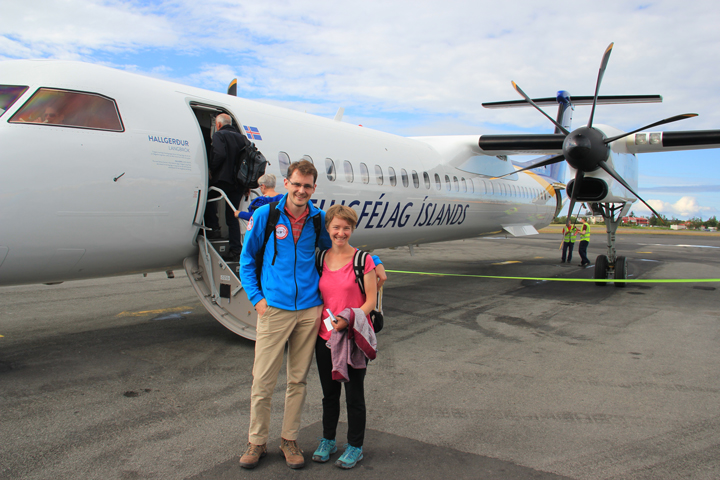
Olivia and I about to board the plane to Kulusuk.
The current weather in Kulusuk is absolutely splendid: blue skies, light wind and around 5 C (about 40 F). This also provided us with very nice views from the plane. One hour into the flight, the dark mountains of the Greenlandic coast appeared, covered in snowy patches or more permanent glaciers. Behind them, in the distance, the vast white ice sheet was visible. As we flew closer, the icebergs drifting in the ocean also become more and more impressive. Glaciers that terminate in the ocean sometimes lose large portions of their floating part as icebergs, which can ‘survive’ for quite some time in the ocean. The white ice in contrast with the light blue water surrounding is really stunning. After 15 minutes of watching in awe and snapping photo after photo, we landed on the dirt runway of the Kulusuk airport.
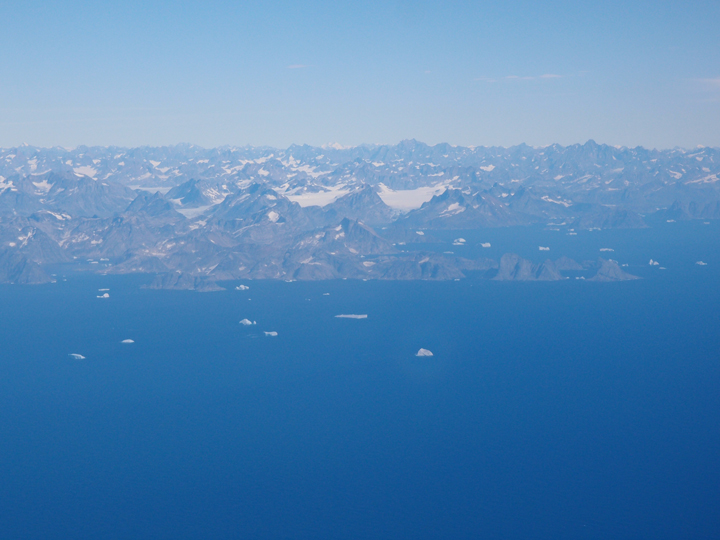
First view of the coast of East Greenland. The ocean is filled with enormous icebergs.
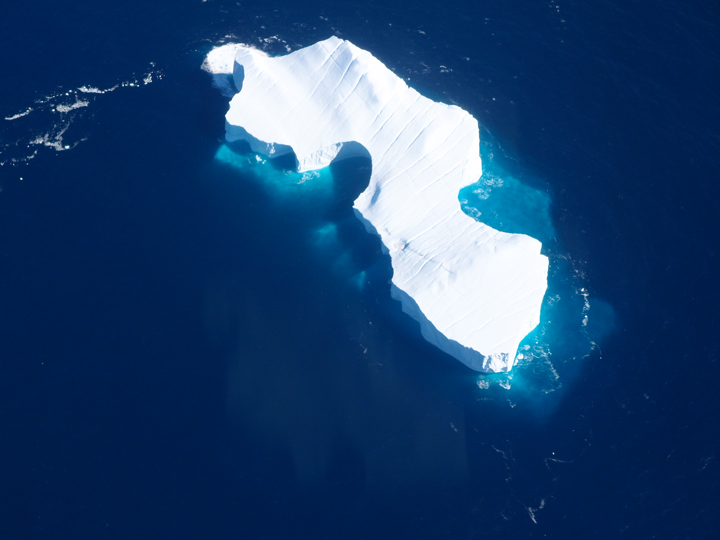
Fantastic view of a huge iceberg; the walls are likely 10-20 meters high. Also note the nice crevasses (the diagonal lines) on the surface.
We brought our bags to Hotel Kulusuk, which is actually the only hotel in the village of Kulusuk, and decided to use the rest of the day to check on all our equipment. Most of the tents, sleeping bags, and science equipment is stored in a large container at the airport. We walked to the airport (about 20 min) and on our way there, we heard a loud noise and saw part of a gigantic iceberg collapse, very impressive.
At the airport, we luckily found all 33 boxes we shipped this spring nicely stacked in a corner of the building. With that, the big inventory could start! We unloaded the container and organized everything in different categories: camping, science, snow mobile, and not-needed-this-year. We made great progress, but need a couple more days to organize everything and put it in boxes (about 70 in total!). In the end the limiting factor is the weight that can be carried by the helicopter. The schedule for the coming days is that Rick and Kip arrive Sunday, Nick on Monday, and on Wednesday and Thursday we get transferred to the field site. At least, that’s the plan.

Clem and Olivia using airport baggage carts to move our boxes filled with equipment.
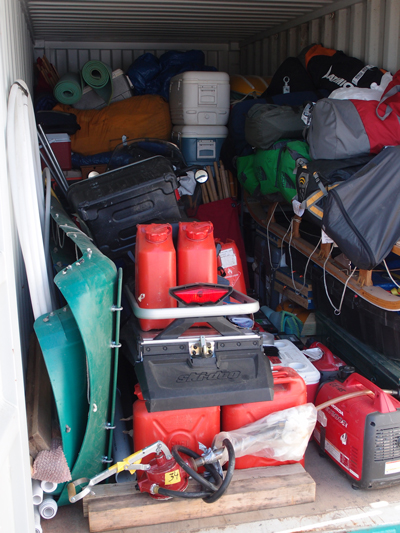
All our stuff in the container.
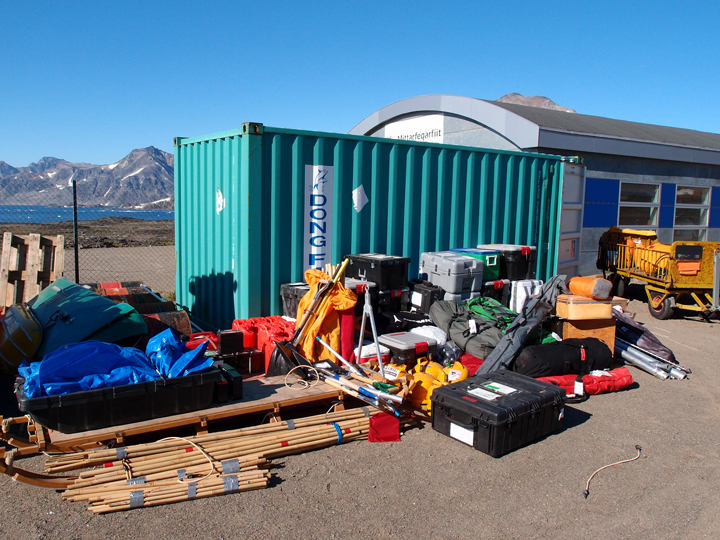
All our stuff out of the container.
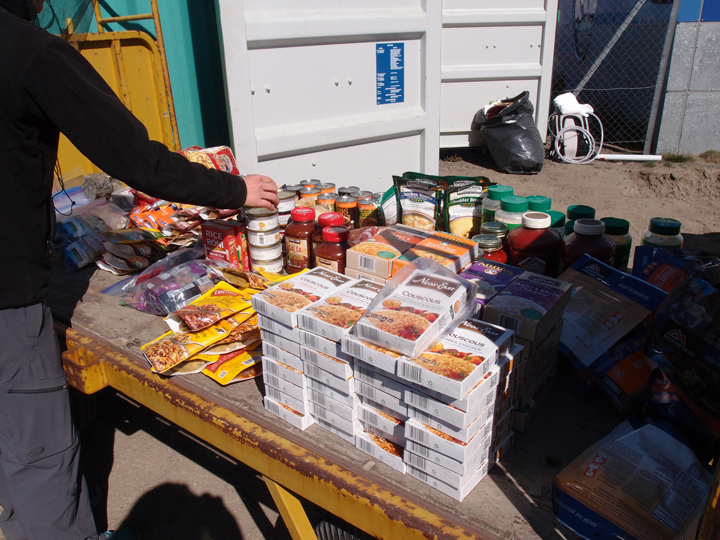
Our dinners for the next three weeks.
Finally, a little bit about myself. I am Stefan Ligtenberg and a post-doc at Utrecht University in The Nethelands. During my current 3-year project, I aim to simulate 3D water flow in the firn aquifer using a computer model (vertical percolation of surface meltwater through the snow to recharge the aquifer and lateral flow downslope within the aquifer). To do so, I use a snow model in combination with an adapted groundwater flow model. One of the important constraints for these models is the so-called hydraulic conductivity; how fast can the water move through the porous snow. One of the main goals of this years field work is to better measure this conductivity.
Greetings from Greenland,
Olivia, Clem and Stefan.
We are ready for the big day! Tomorrow (Wednesday) we will start our put-in to the field. With a total of 5 helicopter flights all our gear, science equipment and the entire team will be flown to our field site, approx. 130 km northwest of Kulusuk. However, we have to take the weather in account; if it is foggy on the ice sheet the helicopter will not be able to land and the put-in will be postponed. So, fingers crossed!

View from the village of Kulusuk. Great weather!
During the past three days, the team arrived according to plan: Rick and Kip on Sunday morning and, last but not least, Nick on Monday morning. Having the entire team in Kulusuk made the organization of the equipment rather quick and smooth. To give you an idea of the preparations we have done: we checked and strengthened about 100 bamboo stakes, repaired tears in the tents, tested the generators, checked the gasoline on contamination with water, charged ~20 batteries, and every group sorted and tested their own science equipment. In the end, we had 132 packed and weighted items ready to be taken to the field.
This afternoon the BlueWest helicopter arrived from Reykjavik with our two pilots Johannes and Nicola. They crossed the ocean from Iceland to Greenland on the narrowest part as that is about the maximum distance the helo can fly. From there they followed the Greenland coast southward till Kulusuk. On the way, they saw seals and a group of 10 whales from the helicopter. That must have been an awesome sight!

Kip replacing the coupling on the borehole liners.
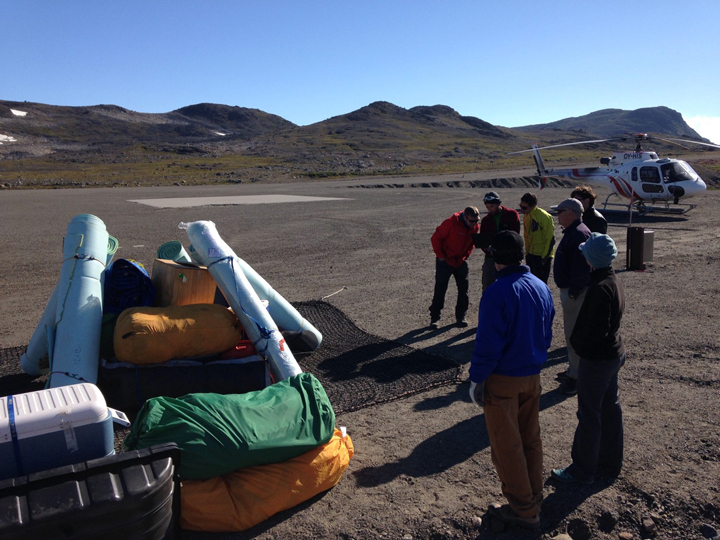
Packing the first sling load with the BlueWest helicopter on the right.
Today, we also had time to test and practice our drone-flying skills! This year, we brought a drone with us for both a serious and less serious goal. First the serious one, we will use it to scan the lowest section of our study area for crevasses. These cracks in the ice are very dangerous as they can be very deep, so it is not advisable to go close to them! However, as the ice sheet is very flat you sometimes cannot see them until you are dangerously close. With the drone we hope to spot them earlier and keep a safe distance. Next to this, the drone will be able to make a number of priceless pictures and videos of us doing science.

Photo from the drone: Nick, Stefan, and Rick in front of Hotel Kulusuk.
Now it is time to finish packing, take a last shower and go to sleep. Tomorrow, there are three flights scheduled: first our camping equipment will be flown in by sling, followed by a part of the team who will set up camp. The science equipment will be flown in next. The next day, the snow mobile and fuel are brought in followed by the last passenger flight. At least that is the plan, the weather can still change everything…!
Greetings from Kulusuk! Olivia, Nick, Clem, Rick, Kip, and Stefan.

The view from Hotel Kulusuk, looking at tefnow-free mountains.
Welcome back to our blog! We’re here for one more season of field work on the Greenland ice sheet to study the firn aquifer. Surface meltwater percolates through the upper layers of compacting snow, or firn, and pools inside the air space between sow grains, forming a large reservoir of liquid water within the ice sheet. We’re trying to figure out how much water is in the aquifer, how fast the water flows, and if and where it is leaving the ice sheet to potentially flow into the ocean. We need to learn more about the firn aquifer because it is a huge reservoir of meltwater in the ice that was only discovered in 2011, and it could have big impacts on how the ice sheet melts and causes sea level rise. This is one of the most exciting parts of science – new discoveries are always being made!
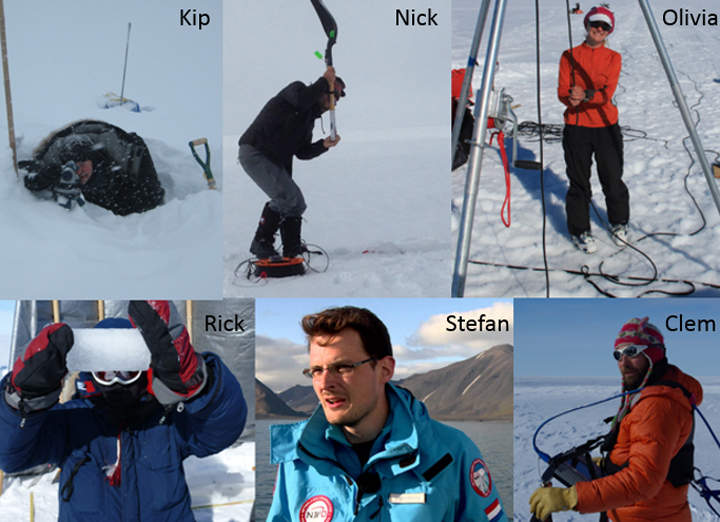
Our team this year consists of Rick Forster, Kip Solomon, Clement Miege, and Olivia Miller from the University of Utah, Nick Schmerr from the University of Maryland, and, our newest member, Stefan Ligtenberg from the University of Utrecht.
We plan to do some similar experiments as last year (see our past blog posts) but in new locations to see how the aquifer changes in different places, and we also have a few new experiments up our sleeves to try to fill in some knowledge gaps that we discovered following the two field campaigns last year. That is another fun thing about science – through your work, you discover new information you need, and then you get to design new ways to get that information.

View of Kulusuk from the air.
We will spend a few days in Kulusuk getting our equipment ready for the helicopter flights out to the ice sheet. When we get to the ice sheet, we will set up camp, and then get to work. We plan to spend 3 weeks on the ice.
Our science plan for this year includes:
This year we have a new, exciting partnership with a research project called STEM Ambassadors. The STEM Ambassadors team is trying to learn about ways to improve science outreach, and so I have volunteered to try some new outreach activities out for them. I wrote a short children’s book about our field work for the school in Kulusuk, and had it translated into West Greenlandic and Danish. This was a very new type of writing for me, but I had a lot of fun! I’ll pass the book along to the teachers in Kulusuk so they can share it with their students when school begins in the fall. If you want to see the book, you can find it here. Any feedback is welcome!
We’ll update the blog regularly over the next few weeks, and look forward to learning more about this unique feature of the Greenland ice sheet! Also, please feel free to leave us a note at the bottom of the page.